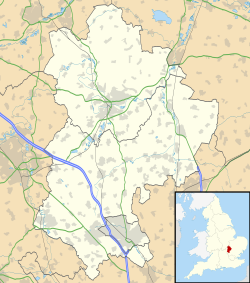Description
The remains of the 700-year-old priory stand today neighbouring a light industrial estate, and disused airfield, and lie between the villages of Colmworth and Little Staughton. Nothing survives of the priory church, and all but the refectory and kitchen of the claustral buildings have disappeared.
Never a large house, the community appears to have consisted of the prior and up to four canons.
The priory was founded around 1195 by William, Chaplain of Colmworth. [1] Hugh de Beauchamp of Eaton Socon endowed the priory with 28 acres (113,000 m2), the priory also held land around Coppingford chapel; during these early years it also held a considerable number of Selions, given to them by local people as gifts of faith. Around 1206 King John permitted the monks to enclose and clear part of the nearby Perry woods.
After William's death in 1215, Joseph, Chaplain of Coppingford, became head of the fraternity. Under his guidance the house became an Augustinian priory. The Augustinians, were then a comparatively new order, which ordained priests, but lived in community similar in style to monks.
Throughout the following years the priory prospered through gifts and grants. The monks wrote documents illustrating their daily lives, these became books of charters, called Cartularies. Unfortunately through the centuries very few of these charters have survived.
It was common for monastic orders at this time to be the beneficiaries of generous donations. However, it was equally common for disapproving heirs to object to the size of these gifts donated from their potential estates. One such heir was John Pateschull, unhappy at a bequest of £8 per annum in the will of his grandfather, after a dispute lasting many years, he had had the priory's cattle seized. Richard of Staughton, a senior Canon and later prior of Bushmead, called the bailiff and set out to recover them. The senior Canon was seized by John Pateschull's men and imprisoned. The dispute was finally ended through arbitration.
When Richard of Staughton became prior, he obtained permission from the bishop to form a boys' school; however it is thought he died of the Black Death before the project could be implemented.
The prior in 1418 was Robert Tychemerssh. [2]
Following the Dissolution of the Monasteries by Henry VIII, the ownership of Bushmead Priory became the subject of a dispute between the St. John family of Bletsoe and Sir William Gascoigne of Cardington, the latter being Cardinal Wolsey's controller of the household. He had previously exchanged land with King Henry VIII and sought further recompense. The King waited until 1537, almost a year after the priory's dissolution, before allowing the priory to pass to Sir William.
Fifteen years later, in 1562, a Cambridgeshire man, William Gery, purchased the estate and almost immediately began building on the site of the priory. Around a hundred years later Richard Gery extended the site and formed a mansion (since demolished). There have obviously been many changes to the priory. A new floor, and fenestration (in the lower section) were fitted circa 1500, although only the rafters now remain. Clearly visible, though, are the major and various subsequent minor alterations, giving an interesting insight into its architectural history.
It is a rare example of King post, and timber frame roof architecture. [3]
The site is now in the care of English Heritage and is open to the public at weekends during Spring and Summer.

The dissolution of the monasteries, occasionally referred to as the suppression of the monasteries, was the set of administrative and legal processes between 1536 and 1541, by which Henry VIII disbanded Catholic monasteries, priories, convents, and friaries in England, Wales, and Ireland; seized their wealth; disposed of their assets, and provided for their former personnel and functions.

Gisborough Priory is a ruined Augustinian priory in Guisborough in the current borough of Redcar and Cleveland, North Yorkshire, England. It was founded in 1119 as the Priory of St Mary by the Norman feudal magnate Robert de Brus, also an ancestor of the Scottish king, Robert the Bruce. It became one of the richest monastic foundations in England with grants from the crown and bequests from de Brus, other nobles and gentry and local people of more modest means. Much of the Romanesque Norman priory was destroyed in a fire in 1289. It was rebuilt in the Gothic style on a grander scale over the following century. Its remains are regarded as among the finest surviving examples of early Gothic architecture in England.
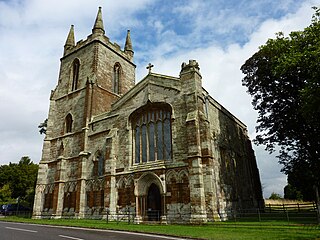
Canons Ashby Priory was an Augustinian priory at Canons Ashby, Northamptonshire, England.
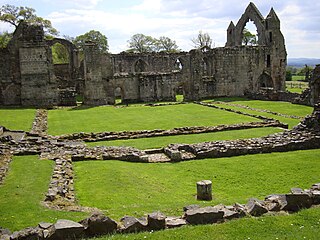
Haughmond Abbey is a ruined, medieval, Augustinian monastery a few miles from Shrewsbury, England. It was probably founded in the early 12th century and was closely associated with the FitzAlan family, who became Earls of Arundel, and some of their wealthier vassals and allies. It was a substantial, successful and wealthy house for most of its four centuries, although evidence of abuses appeared before its dissolution in 1539. The buildings fell into disrepair and the church was largely destroyed, although the remains of some of the domestic buildings remain impressive. The site is now in the care of English Heritage and is open to the public throughout the year and free entry.

Chicksands Priory is a former monastic house at Chicksands in Bedfordshire.

Llanthony Priory is a partly ruined former Augustinian priory in the secluded Vale of Ewyas, a steep-sided once-glaciated valley within the Black Mountains area of the Brecon Beacons National Park in Monmouthshire, south east Wales. It lies seven miles north of Abergavenny on an old road to Hay-on-Wye at Llanthony. The priory ruins lie to the west of the prominent Hatterrall Ridge, a limb of the Black mountains. The main ruins are under the care of Cadw and entrance is free.

Breadsall Priory is a former Augustinian priory in Derbyshire, situated around two kilometres north of Breadsall, and two kilometres east of Little Eaton. The priory was established before 1266 by a member of the Curzon family. Only a small priory, Breadsall was dissolved in 1536.
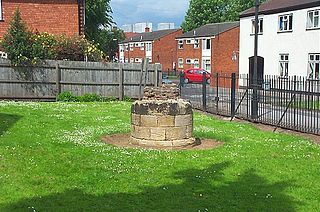
Lenton Priory was a Cluniac monastic house in Nottinghamshire, founded by William Peverel circa 1102-8. The priory was granted a large endowment of property in Nottinghamshire and Derbyshire by its founder, which became the cause of violent disagreement following its seizure by the crown and its reassignment to Lichfield Cathedral. The priory was home mostly to French monks until the late 14th century when the priory was freed from the control of its foreign mother-house. From the 13th-century the priory struggled financially and was noted for "its poverty and indebtedness". The priory was dissolved as part of King Henry VIII's Dissolution of the Monasteries.

The Priory Church of St Peter with its monastery was founded in 1132 by Henry I for Augustinian Canons in Dunstable, Bedfordshire, England. St Peter's today is only the nave of what remains of an originally much larger Augustinian priory church. The monastic buildings consisted of a dormitory for the monks, an infirmary, stables, workshops, bakehouse, brewhouse and buttery. There was also a hostel for pilgrims and travellers, the remains of which is known today as Priory House. Opposite the Priory was one of the royal palaces belonging to Henry I, known as Kingsbury.

Hatfield Broad Oak Priory, or Hatfield Regis Priory, is a former Benedictine priory in Hatfield Broad Oak, Essex, England. Founded by 1139, it was dissolved in 1536 as part of Henry VIII's dissolution of the monasteries.

Newburgh Priory is a Grade 1 listed Tudor building near Coxwold, North Yorkshire, England.

Caldwell Priory was a priory of Canons of the Holy Sepulchre in Bedfordshire, England, from c. 1154 to 1536. It was situated in the south-west of Bedford on the south bank of the River Great Ouse.
Melchbourne Preceptory was a priory in Melchbourne, Bedfordshire, England. It was established in the 12th century and disestablished around 1550.
Newnham Priory was a priory in Newnham, Bedford, Bedfordshire, England.

Leonard Stanley Priory was a priory in Gloucestershire, England. Over the years following the dissolution most of the buildings of the priory complex have been destroyed.

Kirby Bellars Priory was a small priory of Canons Regular of Saint Augustine in Leicestershire, England. It is now the Church of England Parish Church of Saint Peter's serving the village of Kirby Bellars.
Horsley Priory was a medieval, monastic house in Gloucestershire, England.
Longleat Priory was a priory near Warminster, Wiltshire, in the south of England. A short-lived priory was established and dissolved near to Longleat in the 12th century. The main priory was established before 1233 and was under the control of the Dean of Salisbury until its dissolution in 1529.
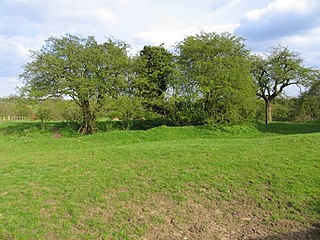
Brooke Priory was a minor house of Augustinian monks in Brooke, Rutland. It was a cell of St Mary's Abbey, Kenilworth.
